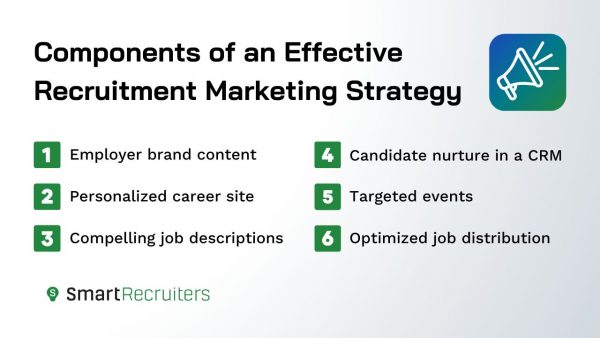Any company looking to find more people to buy its products invests in marketing. When it comes to letting more people know about a company’s jobs, however, the many activities of effective marketing may not be at the top of recruitment teams’ minds. Getting beyond job board “post and pray” tactics entails enlisting all the components of an effective recruitment marketing strategy and applying them holistically to target audiences.
What is recruitment marketing?
Recruitment marketing includes all the activities companies undertake to attract talent to their open roles. It involves reaching potential candidates, educating them about the company and its jobs, and delivering appealing job descriptions in the channels they use most.
What is a recruitment marketing strategy?
A recruitment marketing strategy considers all the components of effective marketing and applies them strategically to fit specific audiences. For example, a company might have a different strategy for recruiting new college graduates than experienced hires. They may also apply different tactics and create different content for warehouse workers versus software engineers.

Components of an effective recruitment marketing strategy
1. Employer brand content highlighting your EVP
The employer brand is an expression of the company brand. Bringing your mission, vision, and values together in one place helps prospective employees discover what makes your company distinct from a competitor down the street.
A strong employee value proposition (EVP) connects with candidates on an emotional and rational level, answering questions such as
- How does it feel to work here?
- How can I expect to be treated?
- What will it be like to work with my colleagues?
- Will I have opportunities for advancement?
- Will I belong as a member of a diverse group?
- How will the company take care of me with benefits and perks?
Employer brand content can highlight the various role types within your organization and offer sample career paths. Testimonials and employee stories from diverse employee groups can help prospective candidates decide for themselves if applying is the right choice.
2. A personalized career site
Branded content is the first step to a winning career site; the second step is a career site that attracts candidates through search engines and delivers personalized information to returning candidates. The technology behind a career site is as important as the content for attracting and converting candidates.
A search-optimized site helps your jobs and career site content appear in organic search results. For example, a job seeker might search for “companies good for diversity in civil engineering.” If your company has a blog post with a similar title, the job seeker could land on your site.
But it doesn’t stop there; a personalized career site can deliver other related content based on previous clicks and invite candidates to sign up for alerts. When the candidate returns, the site remembers their previous clicks and shows additional relevant content.
Our post, Four Amazing Career Sites and Why We Love Them, explores the many creative ways of displaying branded content for audiences in hospitality, healthcare, and business roles.
3. Compelling job descriptions
In consumer advertising, the ad’s message must be compelling to the intended audience. Sometimes, companies forget that the same audience-centric approach applies to job advertising, leading them to use obtuse job titles, non-inclusive language, and unrealistic lists of requirements.
Good job descriptions contain understandable job titles, offer perspective on the purpose of the role, and use inclusive language. Recognizing that job search is a two-way street, the description should reference how the job and the company will benefit the prospective employee, not just what the company wants from the employee.
Job descriptions are crucial in times of talent shortage because many candidates are already employed. Make sure your descriptions appeal to their sense of mission and purpose and point to growth opportunities.
Also, in the age of hybrid work, it’s important to be clear about the on-site expectations. For remote work, indicate how frequently travel will be required for company off-sites.
4. Nurture candidates with a CRM
Email marketing is an essential tactic for many consumer and B2B companies. Email strengthens brand affinity by communicating new offerings, company news, and philanthropic initiatives. With a CRM (candidate relationship management) tool, companies can communicate similar information to job seekers with the goal of encouraging them to apply for a role when the time is right.
Writing candidate emails is a common challenge for recruiting teams, which typically lack marketing training. A generative AI co-pilot within the CRM can help recruiters draft emails based on successful campaigns.
5. Targeted events
Conferences, festivals, and fairs are essential components of many companies’ consumer and B2B marketing strategies. Events enable companies to reach potential new customers face-to-face, build relationships, and offer free samples (if appropriate). While it’s hard to provide a free trial of a job at a recruiting event, in-person contact gives job seekers that human connection that’s impossible to replicate on a screen.
An events strategy can include partnerships with local organizations, career fairs, campus recruitment, and hosting your own job fairs. Because not all attendees may be ready to apply, it’s important to have a system to capture their contact information and nurture them in a CRM during the weeks and months following the event. Many companies use QR codes to direct prospective candidates to a landing page with a form that populates candidate details into a CRM for future follow-up.
6. Optimized job distribution
Advertising is often the first recruitment marketing strategy that comes to mind for employers, but getting job advertising right requires more than just turning ads on and off. Job board contracts can be tedious to manage, and with so many places to post, it’s hard to know which are the best investments. Job distribution software makes it easy to manage job board contracts in one place, post jobs to more than one site from a single tool, and track sources of hire. With source of hire data, companies can adjust their spending to the most effective job boards.
For companies that want to get the most out of job advertising, a managed service like SmartJobs helps them optimize their job campaigns with programmatic advertising based on machine learning technology. Less than 10% of job advertising is managed programmatically, while well over 80% of brand advertising is managed through programmatic means. Programmatic advertising ensures more efficient job distribution so that companies get more of the right candidates for their advertising spend.
Recruitment marketing connects people to jobs
Recruitment marketing is just as necessary for successful hiring success as traditional marketing is necessary for brand success. Companies can reach more people who will become their next great hires by using the right mix of branded content, a compelling career site, well-written job descriptions, candidate nurture, events, and job advertising.
Whether your company is looking for a personalized career site, an applicant tracking system with a CRM, or optimized job advertising, SmartRecruiters can help you develop a recruitment marketing strategy that leverages the technology of today so that you can find the talent of tomorrow. Get in touch with us for a demo to learn more.






